Services on Demand
Article
Indicators
Related links
-
 Cited by Google
Cited by Google -
 Similars in Google
Similars in Google
Share
SA Orthopaedic Journal
On-line version ISSN 2309-8309
Print version ISSN 1681-150X
SA orthop. j. vol.9 n.1 Centurion Jan. 2010
CLINICAL ARTICLE
Immediate postoperative prosthesis (IPOP) utilisation in septic and tumour amputees in a government hospital
R KyteI; R WolfsonII; J EngelbrechtIII
IMBBCh(Rand), FC(Orth)(SA), University of the Witwatersrand and Wits Donald Gordon Medical Centre
IIBTech Medical Orthotics and Prosthetics (TUT)
IIIN Dip Medical Orthotics and Prosthetics (TUT), B Tech Entertainment Technology (Make-up)
ABSTRACT
Rapid rehabilitation of lower limb amputees has far-reaching psychological and economic implications. Postamputation regimens commonly involve the application of a dressing and light compression bandage while awaiting wound healing. This is followed by the application of a coning bandage to facilitate stump reduction, and thereafter fitment of a primary prosthesis. This process commonly takes 17 weeks in transfemoral amputees and 11 weeks in transtibial amputees. A prospective study of 25 amputees (15 males and 10 females) who underwent the application of an immediate postoperative prosthesis (IPOP) was conducted. Utilising this technique, rehabilitation and prosthetic application commence immediately postoperatively within the operating theatre, and run in tandem with stump healing. Mobilisation with crutches or a walker on a temporary prosthesis was achieved within five days for both transtibial and transfemoral amputees, and crutch-assisted mobilisation on a primary prosthesis was attained within four and five weeks respectively. This was attributable to a relative preservation of stump size, muscle strength and cardiovascular fitness, minimisation of contracture development, as well as apparent psychological benefits to the amputees, many of whom were children. The IPOP technique was found to reliably accelerate the rehabilitation of tumour and septic amputees at the Johannesburg Hospital tumour and sepsis unit.
Introduction
Amputation remains an important salvage procedure in septic and tumour patients. The rehabilitation process post-amputation is often protracted, which is extremely costly to both the patient and the health system. This is largely due to the procedure of 'coning' of the residual limb in order to facilitate application of a primary prosthesis.1,2
During this time, muscle strength, tone, general fitness and co-ordination may be reduced, which further retards the rehabilitative process.2 The technique of immediate postoperative prosthesis (IPOP) application attempts to address some of these problems by the application of a rigid cast immediately postoperatively within the operating theatre and attachment of a temporary prosthesis soon thereafter.
Wound healing and rehabilitation progress in tandem, diminishing the effects of muscle wasting and enabling a more rapid mobilisation with a primary prosthesis.
This is not a new technique. The first reports of IPOP usage date back to 1893, when a German surgeon, Von Bier, reported accelerated rehabilitation by using a rigid plaster cast, to which wooden peg legs were attached, immediately following amputation.3 In 1918 Wilson also reported excellent results in the treatment of young, traumatic amputees during World War I.4 In 1957 Berlemont and Wiess reported successfully making use of a thigh cast immediately attached to a below-knee prosthesis, in transtibial amputees.5
IPOPs have also been successfully utilised in South Africa for several decades. Unfortunately, their usage does not appear to have been well documented and this may have contributed to the underutilisation of this technique in latter years. A prospective study of septic and tumour amputees at the Johannesburg Hospital was undertaken to evaluate the advantages and disadvantages of the technique.
Materials and methods
Between April 2005 and April 2009, 25 consecutive patients scheduled to undergo amputation at the tumour and sepsis unit of the Johannesburg Hospital were included in a prospective study of the utilisation of an immediate postoperative prosthesis. There were 15 males and 10 females. The mean age of the group was 29 years. All of the candidates underwent amputation of the lower limb. Seventeen were as a consequence of malignant tumours - 14 patients suffered from osteosarcoma, one from synovial sarcoma, one from Ewing's sarcoma and one from a myxoid soft tissue sarcoma. The other eight patients were amputated due to chronic osteomyelitis. Eighteen of the 25 were amputated transfemorally and seven underwent transtibial amputations. Two of the patients also suffered from diabetes mellitus complicated by peripheral vascular disease, both of whom had a chronic septic, non-united, ankle fracture-dislocation. The mean duration of preoperative non-ambulation was 9 weeks.
All amputations were performed by the same surgical team, and immediate postoperative prostheses were applied by the same prosthetic team.
Assessment of the time taken to independent ambulation with a primary prosthesis was made.
Surgical technique
Standard techniques of transfemoral and transtibial amputation were employed. Meticulous haemostasis was achieved prior to closure and a drain was avoided in all but two cases where a Lautenbach suction-instillation system was incorporated within the rigid dressing. A dry dressing and padded Elastoplast® pressure bandage were applied to the stump prior to IPOP application (Figure 1).

IPOP technique
All of the materials utilised in the application of our IPOPs were readily available at the Johannesburg Hospital - and are those usually available in most state or private hospitals, namely: foam, orthopaedic felt, fibreglass casting material, Plaster of Paris bandages, the lower end of an elbow-crutch (to form the pylon), and stockingette (Figure 2).
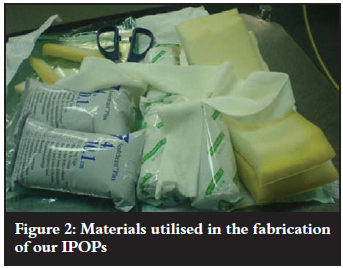
Transfemoral technique
A pre-manufactured proximal brim is applied, which is used for ischial weight bearing (Figure 3).
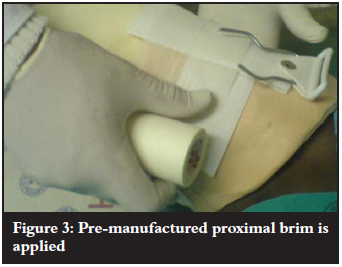
The IPOP is suspended with a belt around the shoulder and then the residual limb is covered with orthopaedic wool and stockingette (Figure 4).
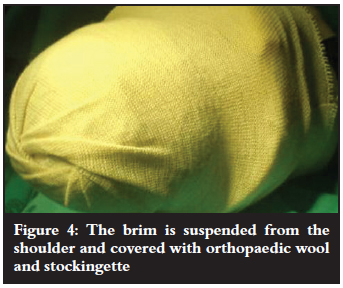
Plaster of Paris bandage is applied, ensuring that there are no points of pressure. Even tension is adopted to encourage lymphatic drainage and minimise residual limb oedema (Figure 5).
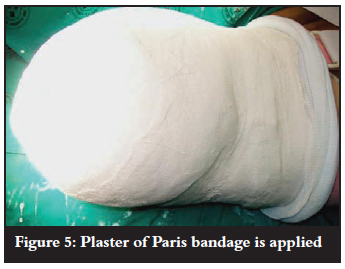
Fibreglass casting bandage is added to provide a rigid exterior (Figure 6).
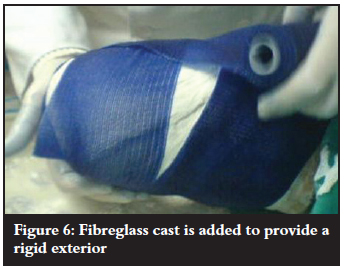
A pylon is attached to the dressing two days following surgery, after which the patient commences touch weight bearing on the IPOP, making use of a walker. A greater degree of weight bearing was discouraged in an attempt to minimise inadvertent damage to the healing surgical wound (Figure 7).
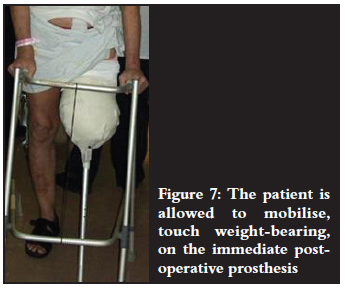
Transtibial technique
This is very similar to that of the transfemoral IPOP, apart from the fact that felt is cut, shaped and applied to protect bony prominences (Figure 8) and orthopaedic wool is applied, together with stockingette (Figure 9).
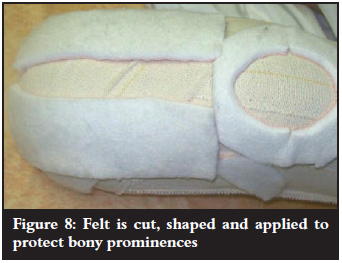
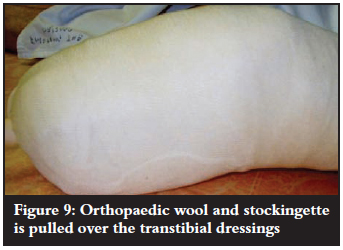
Plaster of Paris and fibreglass casting bandages are applied, as for transfemoral, in order to create a hard exterior (Figure 10).
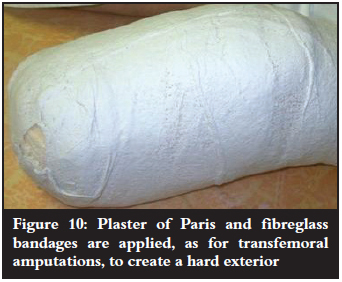
Clinical monitoring was undertaken, in terms of observing for excessive, persistent discomfort within the residual limb or untoward local odour development, which may herald local wound complication or systemic signs of sepsis, as might be expected with abscess formation, for example. It is routine practice, in our bone sepsis unit, not to disturb dressings, lower limb casts or splints until the wound is fully healed (usually 10-14 days) for fear of cross-contamination. Should local wound problems arise, they would be dealt with at this stage, and usually with surgical wound revision debridement. Therefore, the fact that wounds were not inspected earlier than 14 days was not unusual practice for us. The onset of any of the above signs or symptoms would have been deemed grounds for removal of the IPOP and wound inspection. A decision with regard to discontinuation or reapplication of the IPOP would then be taken.
The rigid dressing was removed at two weeks postoperatively, the wound inspected and clips removed. Measurement and fitment of the primary prosthesis was then performed. An elasticised crepe bandage was reapplied after IPOP removal and physiotherapy undertaken while the patients awaited fitment of the primary prosthesis. Depending on logistical constraints, the patients were fitted with their primary prosthesis between 3 and 4 weeks post amputation (Figure 11).
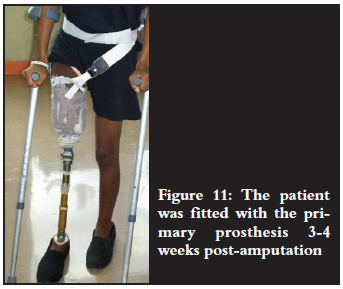
Results
In comparison to conventional methods, patients were ambulant with a primary prosthesis 7 weeks and 12 weeks more quickly in transtibial and transfemoral amputees, respectively, as illustrated by Table I.6

All patients had sufficient strength to mobilise with an IPOP and this appeared to corroborate the relative maintenance of strength, fitness and control of the residual limb, as documented by other authors. There was no early shrinkage of the residual limb compared to pre-IPOP application as assessed clinically at the time of clip removal. However, ultimately, there was some reduction in residual limb size recorded as would be expected with any amputation technique. Nevertheless, no patients underwent prosthetic changes prior to 6 months postoperatively. It is common to undergo early prosthetic changes (prior to 6 months postoperatively) with the conventional technique.1,2,6 This appeared to further corroborate the benefits of IPOP in preservation of the residual limb bulk and tone.
We had only one patient who developed superficial local wound infection, which was successfully treated with dressings. This was deemed to be secondary to local wound dehiscence, which occurred when this patient had been discharged home while awaiting her primary prosthesis. The patient had removed and refitted her own IPOP at home and this might have been instrumental in the injury. No patients required abandonment or premature removal of their IPOP.
Discussion
The conventional way of treating amputations postoperatively involves the application of a soft dressing while awaiting wound healing.
Thereafter the stump is coned, producing shrinkage of the residual limb, before fitment and mobilisation with a primary prosthesis can be achieved. Utilising this so-called 'conventional' technique, measurements for a primary prosthesis can only be taken 6 to 8 weeks post amputation, and ambulation with the prosthesis is classically possible between 11 and 17 weeks depending on the level of amputation.8 However, with the IPOP technique, immediate measurements could be taken for a primary prosthesis 2 weeks postoperatively, during wound inspection and clip removal.6
Seymour felt that the advantages of IPOP usage were an ability to control and shape the residual limb, protection of the surgical site, maintenance of residual limb and upper body strength, better maintenance of cardiovascular fitness with an earlier return to balance and ambulation with a shorter overall recovery time.6 Sindhu also noted that early ambulation following amputation had enormous benefits for the functional outcomes in lower limb amputees.7 He echoed Seymour's findings by documenting a reduced risk of contracture development, diminished pain and oedema, avoidance of relative muscle atrophy, acceleration of wound healing while maintaining postural reflexes, and an overall hastened rehabilitation. We had a similar experience to these two authors within our patient group.
Some potential disadvantages of this technique were considered to be difficulty in monitoring wound healing as well as the possibility of a prolonged hospital stay, especially logistically in a developing world setting. Neither of these was encountered in our study and patients were discharged as soon as they were mobile, and were successfully treated thereafter on an outpatient basis.
In addition, Seymour suggested the following conditions as contraindications:
• patients with expected delayed wound healing (such as patients with vascular compromise and/or diabetes mellitus, morbidly obese patients or those with preoperative limb oedema), frail patients and patients who had been bedridden for more than 45 days preamputation.4 Many of our sarcoma patients had presented to our unit with massive tumours and pathological fractures. Cachexia, in some, prevented mobilisation with these extremely large tumours. Pain, due to femoral pathological fractures, septic non-united fractures, as well as osteosarcomatous muscular tethering, had hampered mobilisation in others.
Although our study had small numbers, we were unable to validate these concerns. In fact, one of our successful IPOP patients was a 65-year-old sarcoma sufferer who underwent a transfemoral amputation and had been nonambulant for 3 months pre-operatively. The patient, who developed superficial wound infection, had normal peripheral circulation and no comorbidities.
Furthermore, significant psychological benefits were apparent to the patients, in terms of replacing the amputated limb immediately with a tangible prosthesis. Sindhu also noted significant psychological benefits to his patients and felt this had a positive influence on their rapid rehabilitation.7 Our patients, too, were noted to channel their grief at losing their limb towards rather determinedly accomplishing rapid independent mobility. This was facilitated by continuous motivation from the health care team. A 22-year-old sarcoma sufferer was delighted to be able to attend his university graduation ceremony 3 weeks post transfemoral amputation, independently mobile utilising his primary prosthesis (Figure 12).

Conclusion
The results of our small study are encouraging and indicate that the use of an IPOP may be a safe and reliable technique to facilitate rapid ambulation post-amputation. There were definite physical and, although we did not specifically test for it, apparent psychological benefits, to patients requiring amputations for musculoskeletal malignancy or infection.
References
1. Gailey RS. Preparing for a prosthetic fitting. First Step 2001; 2:111-128. [ Links ]
2. Nasser E. Amputation rehabilitation. In: O' Young B, Young MA, Stiens SA(eds). Physical Medicine and Rehabilitation Secrets. Philadelphia: Hanley and Belvis; 2003: 553-561. [ Links ]
3. Walsh TM. Custom removable immediate postoperative prosthesis. JPO 2003; 15:161-8. [ Links ]
4. Smith DG, McFarland LV, Sangeorzan BJ, Reiber GE, Czerniecki JM. Postoperative dressing and management strategies for transtibial amputations: A critical review. JPO 2004;16:15-26. [ Links ]
5. Tang P. Let them walk! Current prosthesis options for leg and foot amputees. JACS 2008;206:548-60. [ Links ]
6. Seymour R. Immediate Postoperative Prosthesis (IPOP) Protocols. In: Prosthetics and Orthotics: Lower limb and spine. Philadelphia: Lippincott & Williams; 2002: 161-163. [ Links ]
7. Sindhu V, Singh U, Wadhwa S, Yadav SL. Advantages of ischial weight bearing immediate postoperative prosthesis. IJPMR 2002;13:5-11. [ Links ]
8. Vigier S. Healing of open stump wounds after vascular below-knee amputation: plaster cast socket with silicone sleeve versus elastic compression. Arch Phys Md Rehabil 1999;80:1327-30. [ Links ]
 Reprint requests:
Reprint requests:
Dr R Kyte
Wits Donald Gordon Medical Centre
18 Eton Rd Parktown 2193
Tel: (011) 726-0000 Fax: (011) 726-0001
Email: richard@rdkyte.co.za
All subjects included in this study provided their written informed consent and the study was ethically validated. No benefits of any form have been received from a commercial party related directly or indirectly to the subject of this article.














